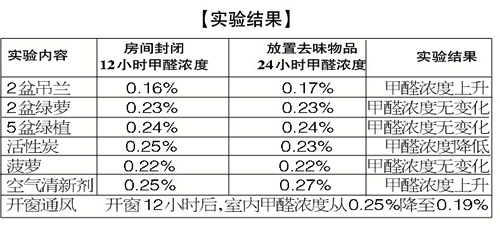Plants absorb formaldehyde very limited window ventilation can remove slight pollution of formaldehyde
Mr. Cao’s new home in Changchun, Jilin Province, always has a pungent smell after renovation. I heard that green radish can remove formaldehyde, he bought dozens of pots in every corner. "A month later, I found a professional to test, indoor formaldehyde is still over 4 times more than standard..." Mr. Cao sighed.
After the renovation of the new home, the first thing many people do is to remove formaldehyde, place green plants, activated carbon, pineapple, and air freshener... What are the effects of these folk methods? We will use experiments to verify.
[Experimental content]
Experimental items: spider plant, ivy, green radish, activated carbon, pineapple, air freshener.
Laboratory equipment: indoor air detector.
Experimental expert: Li Zhenbing, environmental management consultant of Changchun Taiyuan Technology Co., Ltd.
Experimental method: put a small box of paint in a room of 18 square meters, and measure the formaldehyde concentration after 12 hours of closure; then put the plant, activated carbon, pineapple and air freshener separately, and measure the formaldehyde concentration after 24 hours.

[Expert Interpretation]
Plants absorb formaldehyde very limited
Horticultural experts say the results of the experiment do not negate the efficacy of the plant. Plants such as spider plant have certain ability to adsorb formaldehyde, but the amount is very limited, and the plant absorbs formaldehyde by photosynthesis. It only works during the day, and the plants exhale harmful gases at night. Therefore, it is not obvious that plants rely on plants to absorb formaldehyde.
Activated carbon is easy to adsorb and saturate
Activated carbon can only absorb harmful substances that have been volatilized, and the effect is not obvious in rooms with serious pollution. Moreover, activated carbon is easy to adsorb and saturate. Generally, the effective adsorption period of activated carbon is 5 to 8 months. After this period of time, the harmful gas will be released again, and it needs to be taken out to dry regularly.
Pineapple can't absorb formaldehyde
From the experimental results, after the pineapple was placed, the indoor formaldehyde concentration did not change, but the indoor air was fresher. This is because the pineapple will evaporate the aroma and play a certain role in covering the odor, but it does not decompose and remove harmful substances. Some air fresheners themselves have formaldehyde components, which can cause secondary pollution.
Window ventilation can remove slight pollution of formaldehyde
Newly renovated houses and newly purchased furniture, if the pollution is slight, can be ventilated to allow indoor air to be emitted. The experimental results show that this is more reliable than placing plants. After a few months of general decoration, the indoor formaldehyde concentration can be reduced to below 0.08 mg/m3, which meets the indoor qualified standard.
250X8Mm Pvc Panel,Corrugated Pvc Panel,Vinyl Wall Panel,Pvc Wall Panels
ZHEJIANG DEQING GONAT FENCE CO.,LTD , https://www.gonatpvcfence.com